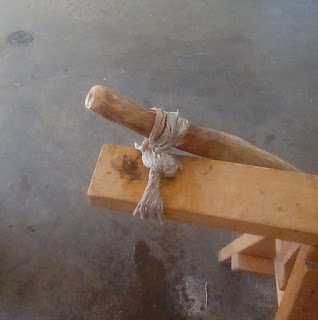Processing Kindle
To make my summer fires which are small tools to heat a kettle of water or render, I look for barkless, dry dead sticks - as these are often dry through and don't harbour insect homes - about the width of two thumbs. Thinner burns easley but faster, and therefore needs to be fed sooner; wider, the opposite, burns slower, needs to be fed less, but will not catch as quick or roar as hot
Lets say, you dont have a tomahawk or small axe at hand; to process the wood into the desired finger long sticks, put the stick, where you want to make the break, over the round of a hard dead log or rock, and with another big stick, strike just forward of the contact point to crack up the kindle stick.
Yet another method is to hold the stick to be broken on a 45 degree angle touching a hard surface. Strike with a rock two inches up the stick from the contact point.
A third way if you have no hard surfaces or rocks to strike with, is to hold the stick 45 degrees from the ground and just push into it.
Finally, you can break thick kindle over a hard rock by whacks at about a third of the way from the end. Doing this will hurt the hand at first, but you will eventually get a feel for exactly where the log must be struck so there is no vibration transfer to your hand.
Leather gauntlet mitten are essential in winter as they have myriad of uses. You can kneel on them briefly and avoid pant tares, sit on them, and lay them over your leg before breaking sticks to avoid wear to your pants.
These tricks are important as it will spare your pant knees and shirts from developing rip holes by breaking the sticks there.
In winter, a small hand axe for processing a fire fuel is key. You dont need a big roaring fire pit fire with split dry lumber for cooking a pot or getting your hands warm - the axe or tomahawk, will butcher as many dead standing spuce for a good two hour fire in seconds.
If you harvest more dead standing than you need, stand it upright instead of laying it down to store; they will get less wet in heavy rain.


